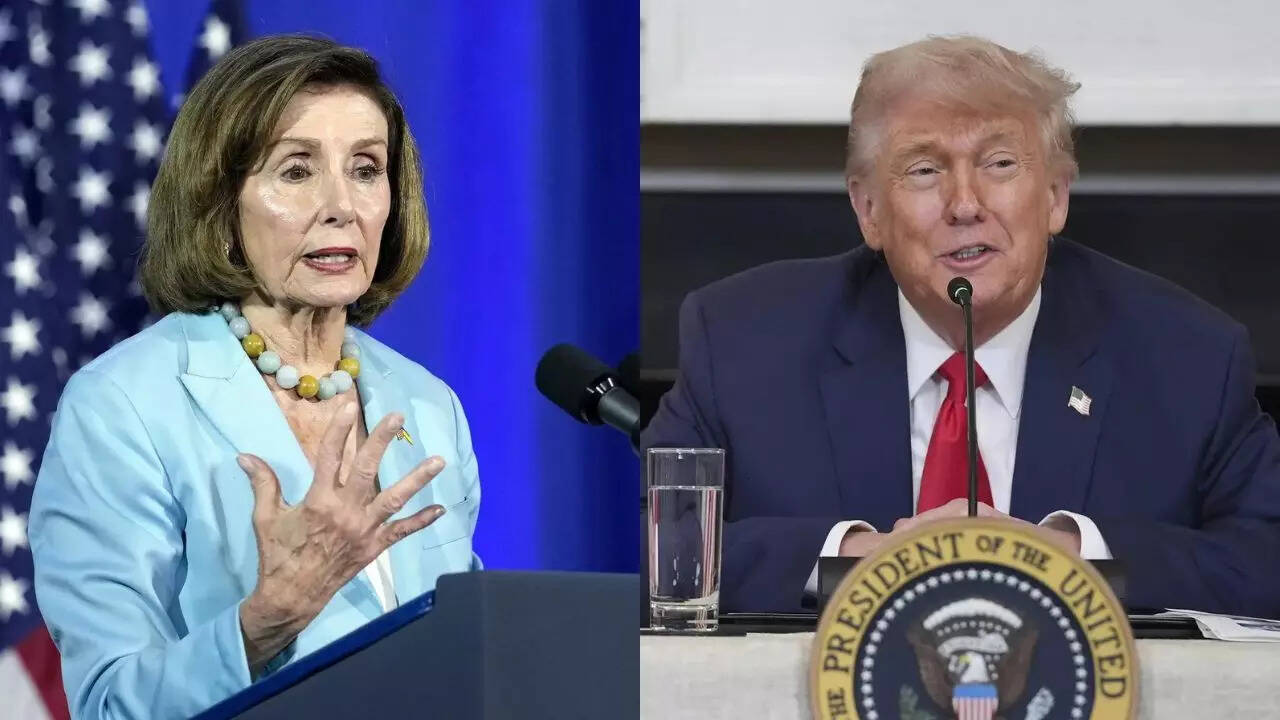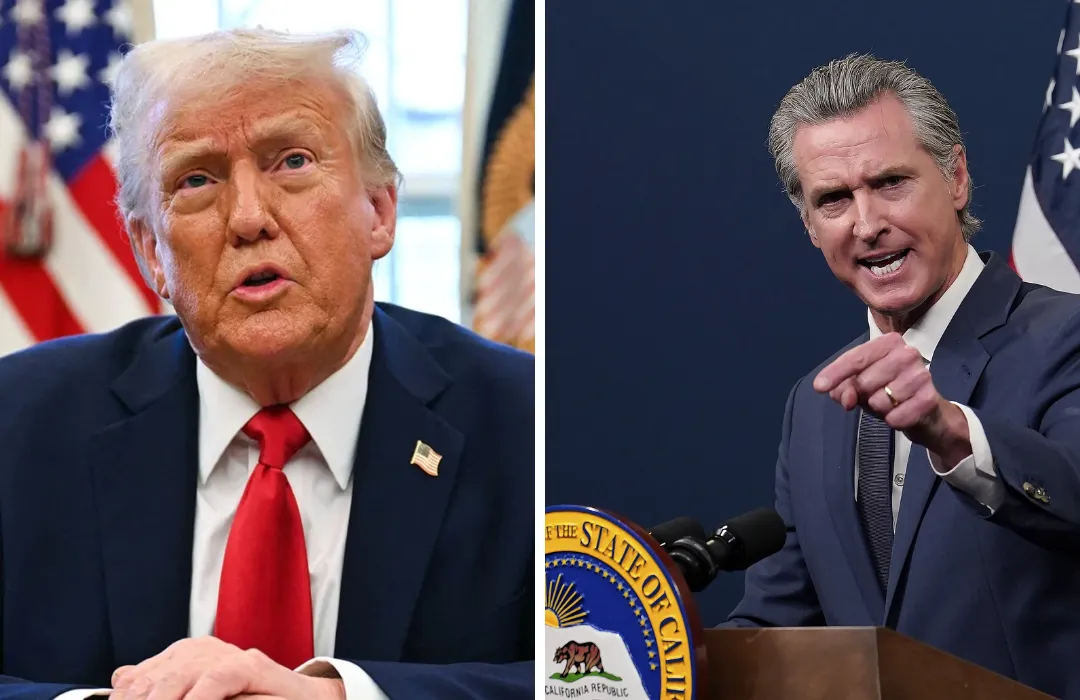
Former Speaker Nancy Pelosi (D-Calif.) lashed out at President Donald Trump on Tuesday for deploying the National Guard to assist in quelling protests in Los Angeles, calling attention to what she sees as his refusal to deploy similar forces when a violent mob stormed the U.S.
Capitol on January 6, 2021. The move reignites the political dispute over Trump’s actions surrounding the January 6 Capitol insurrection, with Pelosi accusing him of hypocrisy and poor judgment.
Pelosi’s remarks came after President Trump authorized the National Guard’s involvement in Los Angeles to address protests that had erupted in response to Immigration and Customs Enforcement (ICE) raids.
Despite opposition from California Governor Gavin Newsom and Los Angeles Mayor Karen Bass, both of whom argued that Trump’s intervention risked escalating violence, the White House maintained that local officials had not done enough to protect federal property or officers.
However, Pelosi was quick to remind the public that when Congress faced violent, anti-democratic actions at the Capitol on January 6, 2021, Trump had refused bipartisan requests to deploy the National Guard.
“In a bipartisan way, on January 6 — with violence against the Constitution, against the Congress, and against the United States Capitol — we begged the president of the United States to send in the National Guard,” Pelosi said to reporters. “He would not do it.”
The events of January 6, 2021, remain a dark chapter in U.S. history. Following months of baseless claims by Trump that the 2020 election had been "stolen," a violent mob of his supporters stormed the Capitol building in Washington, D.C., as Congress was in the process of certifying Joe Biden’s victory in the 2020 presidential election.
The rioters overwhelmed police officers and caused significant damage to the Capitol complex, resulting in roughly 150 law enforcement injuries and five deaths.

While Trump claims he called for the National Guard to be deployed on January 6, there is no evidence to support this assertion. In 2022, Christopher Miller, the acting Defense Secretary under Trump, testified that no formal request had been made by Trump to send the National Guard.
Instead, it was Speaker Pelosi, Senate Majority Leader Mitch McConnell (R-Ky.), and Vice President Mike Pence who made the calls to the Pentagon requesting assistance after the Capitol was breached.
Even with these requests, Pentagon officials were hesitant to act swiftly, fearing the optics of having troops deployed to protect the Capitol from Trump supporters.
It wasn’t until hours later that approval for the National Guard came through, and even then, it took several more hours before the first troops arrived. By the time help came, the damage had been done, and the Capitol was already in chaos.
Pelosi, who was Speaker of the House at the time of the Capitol riot, has been critical of Trump’s actions, particularly his alleged failure to respond in real time to the situation.
Her office also defended her previous comments from a video taken by her daughter on January 6, where she expressed regret over the lack of preparation and security at the Capitol. “I take responsibility for not having them just prepare for more,” Pelosi said in the video, a remark that was later scrutinized by Trump’s supporters.
In response, Pelosi’s office clarified that as Speaker, she does not oversee Capitol security and that the decision-making process was outside her control.
Nevertheless, the incident has continued to haunt Pelosi’s political career, as some see it as an indication that the Capitol’s security apparatus wasn’t properly prepared for such an event.
Despite the controversy surrounding Pelosi’s comments, her condemnation of Trump’s actions on January 6 has been consistent. She has called for accountability for those involved in the insurrection and continues to emphasize the importance of defending democracy and upholding the Constitution.
Fast forward to 2023, and Trump’s decision to send the National Guard to Los Angeles in response to protests against ICE raids raises significant questions about his consistency on the issue.
The protests, sparked by the controversial raids in immigrant communities, were becoming increasingly violent, with confrontations between protestors and law enforcement.
However, while local authorities voiced concerns about Trump’s intervention, he proceeded with sending the National Guard without waiting for approval from California Governor Gavin Newsom or Los Angeles Mayor Karen Bass.
Governor Newsom and Mayor Bass both expressed concerns that deploying the National Guard would only escalate tensions and increase the risk of further violence.
Both leaders argued that local law enforcement was more than capable of handling the situation without federal intervention. Yet, Trump’s administration insisted that it had to act to protect federal property and maintain order.
Pelosi’s remarks about Trump’s deployment of the National Guard in California were scathing. She pointed to the hypocrisy of Trump’s actions, noting that when law enforcement officers were under siege at the Capitol on January 6, Trump failed to act.
Instead of sending in the National Guard, Trump delayed the response, and only after hours of chaos did troops finally arrive.

“When law enforcement people were being harmed — some later died — he would not send [the Guard] in,” Pelosi remarked. “He forgave those people. And yet, in the contra-Constitutional way, he has sent the National Guard into California. Something is very wrong with this picture.”
Pelosi’s statement highlights a central contradiction in Trump’s actions: While he was quick to deploy federal troops in California over protests, he was hesitant to intervene when his own supporters were attacking the Capitol. Pelosi’s criticism underscores her belief that Trump’s priorities were misguided and that he acted only when it suited his political agenda.
Pelosi’s critique of Trump is not only about the tactical decisions made on January 6 and in California but also about the broader implications of those decisions on national security and public trust.
The failure to protect the Capitol on January 6, coupled with the delayed response, has become a symbol of the lack of leadership at the top levels of government.
Trump’s decision to send troops to Los Angeles, on the other hand, raises questions about his motivations.
Was he genuinely concerned about the unrest in California, or was this a political move to support his base by appearing tough on crime and immigration? His actions seem to suggest a level of inconsistency, with his focus on political optics outweighing the broader issues at hand.
The tension between Pelosi’s calls for accountability and Trump’s controversial decisions regarding the National Guard is part of a much larger political struggle.
Since the 2020 election, Trump has been a polarizing figure, with his critics accusing him of undermining democratic institutions and his supporters praising him for challenging the status quo. The fallout from January 6 and Trump’s actions surrounding it continue to reverberate across the political landscape.

Pelosi, for her part, has become a symbol of resistance to Trump’s agenda. As Speaker of the House, she led the impeachment efforts against Trump and has consistently condemned his actions.
Her critiques of Trump’s handling of the Capitol riot and the National Guard deployment reflect her deep concern for the rule of law and the preservation of American democratic institutions.
As we move forward, both Pelosi and Trump will continue to be key figures in the ongoing debate over the future of American democracy.
While Trump’s actions and decisions remain the subject of intense scrutiny, Pelosi’s leadership during and after the January 6 riots will also be analyzed for its impact on the nation’s political future.
The ongoing dispute between Nancy Pelosi and Donald Trump over the National Guard’s deployment in California and the events surrounding January 6 raises critical questions about leadership, accountability, and the preservation of democratic principles. Pelosi’s criticism of Trump for his inaction during the Capitol riot and his subsequent intervention in California highlights the contradictions in his approach to national security. As both figures continue to dominate the political landscape, their actions and decisions will shape the course of future elections and the political climate in the United States for years to come.
-1750316937-q80.webp)


